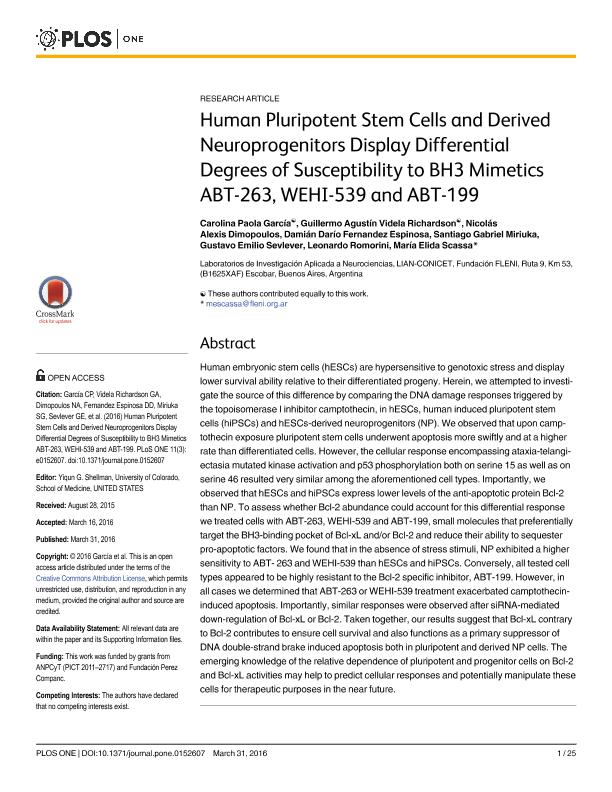Mostrar el registro sencillo del ítem
dc.contributor.author
Garcia, Carolina Paola

dc.contributor.author
Videla Richardson, Guillermo Agustín
dc.contributor.author
Dimopoulos, Nicolás

dc.contributor.author
Fernandez Espinosa, Damián Darío
dc.contributor.author
Miriuka, Santiago Gabriel
dc.contributor.author
Sevlever, Gustavo Emilio
dc.contributor.author
Romorini, Leonardo

dc.contributor.author
Scassa, Maria Elida

dc.date.available
2017-09-05T17:50:21Z
dc.date.issued
2016-03
dc.identifier.citation
Garcia, Carolina Paola; Videla Richardson, Guillermo Agustín; Dimopoulos, Nicolás; Fernandez Espinosa, Damián Darío; Miriuka, Santiago Gabriel; et al.; Human Pluripotent Stem Cells and Derived Neuroprogenitors Display Differential Degrees of Susceptibility to BH3 Mimetics ABT-263, WEHI-539 and ABT-199; Public Library of Science; Plos One; 11; 3; 3-2016; 1-25
dc.identifier.issn
1932-6203
dc.identifier.uri
http://hdl.handle.net/11336/23685
dc.description.abstract
Human embryonic stem cells (hESCs) are hypersensitive to genotoxic stress and display lower survival ability relative to their differentiated progeny. Herein, we attempted to investigate the source of this difference by comparing the DNA damage responses triggered by the topoisomerase I inhibitor camptothecin, in hESCs, human induced pluripotent stem cells (hiPSCs) and hESCs-derived neuroprogenitors (NP). We observed that upon camptothecin exposure pluripotent stem cells underwent apoptosis more swiftly and at a higher rate than differentiated cells. However, the cellular response encompassing ataxia-telangiectasia mutated kinase activation and p53 phosphorylation both on serine 15 as well as on serine 46 resulted very similar among the aforementioned cell types. Importantly, we observed that hESCs and hiPSCs express lower levels of the anti-apoptotic protein Bcl-2 than NP. To assess whether Bcl-2 abundance could account for this differential response we treated cells with ABT-263, WEHI-539 and ABT-199, small molecules that preferentially target the BH3-binding pocket of Bcl-xL and/or Bcl-2 and reduce their ability to sequester pro-apoptotic factors. We found that in the absence of stress stimuli, NP exhibited a higher sensitivity to ABT- 263 and WEHI-539 than hESCs and hiPSCs. Conversely, all tested cell types appeared to be highly resistant to the Bcl-2 specific inhibitor, ABT-199. However, in all cases we determined that ABT-263 or WEHI-539 treatment exacerbated camptothecin-induced apoptosis. Importantly, similar responses were observed after siRNA-mediated down-regulation of Bcl-xL or Bcl-2. Taken together, our results suggest that Bcl-xL contrary to Bcl-2 contributes to ensure cell survival and also functions as a primary suppressor of DNA double-strand brake induced apoptosis both in pluripotent and derived NP cells. The emerging knowledge of the relative dependence of pluripotent and progenitor cells on Bcl-2 and Bcl-xL activities may help to predict cellular responses and potentially manipulate these cells for therapeutic purposes in the near future.
dc.format
application/pdf
dc.language.iso
eng
dc.publisher
Public Library of Science

dc.rights
info:eu-repo/semantics/openAccess
dc.rights.uri
https://creativecommons.org/licenses/by/2.5/ar/
dc.subject
Pluripotent
dc.subject
Genotoxic
dc.subject
Apoptosis
dc.subject
Progenitor
dc.subject.classification
Bioquímica y Biología Molecular

dc.subject.classification
Ciencias Biológicas

dc.subject.classification
CIENCIAS NATURALES Y EXACTAS

dc.subject.classification
Bioquímica y Biología Molecular

dc.subject.classification
Ciencias Biológicas

dc.subject.classification
CIENCIAS NATURALES Y EXACTAS

dc.title
Human Pluripotent Stem Cells and Derived Neuroprogenitors Display Differential Degrees of Susceptibility to BH3 Mimetics ABT-263, WEHI-539 and ABT-199
dc.type
info:eu-repo/semantics/article
dc.type
info:ar-repo/semantics/artículo
dc.type
info:eu-repo/semantics/publishedVersion
dc.date.updated
2017-08-29T15:38:24Z
dc.identifier.eissn
1932-6203
dc.journal.volume
11
dc.journal.number
3
dc.journal.pagination
1-25
dc.journal.pais
Estados Unidos

dc.journal.ciudad
San Francisco
dc.description.fil
Fil: Garcia, Carolina Paola. Fundación para la Lucha contra las Enfermedades Neurológicas de la Infancia; Argentina. Consejo Nacional de Investigaciones Científicas y Técnicas. Oficina de Coordinación Administrativa Parque Centenario. Instituto de Investigaciones Bioquímicas de Buenos Aires. Fundación Instituto Leloir. Instituto de Investigaciones Bioquímicas de Buenos Aires; Argentina
dc.description.fil
Fil: Videla Richardson, Guillermo Agustín. Fundación para la Lucha contra las Enfermedades Neurológicas de la Infancia; Argentina
dc.description.fil
Fil: Dimopoulos, Nicolás. Fundación para la Lucha contra las Enfermedades Neurológicas de la Infancia; Argentina
dc.description.fil
Fil: Fernandez Espinosa, Damián Darío. Fundación para la Lucha contra las Enfermedades Neurológicas de la Infancia; Argentina
dc.description.fil
Fil: Miriuka, Santiago Gabriel. Fundación para la Lucha contra las Enfermedades Neurológicas de la Infancia; Argentina
dc.description.fil
Fil: Sevlever, Gustavo Emilio. Fundación para la Lucha contra las Enfermedades Neurológicas de la Infancia; Argentina
dc.description.fil
Fil: Romorini, Leonardo. Fundación para la Lucha contra las Enfermedades Neurológicas de la Infancia; Argentina. Consejo Nacional de Investigaciones Científicas y Técnicas; Argentina
dc.description.fil
Fil: Scassa, Maria Elida. Fundación para la Lucha contra las Enfermedades Neurológicas de la Infancia; Argentina
dc.journal.title
Plos One

dc.relation.alternativeid
info:eu-repo/semantics/altIdentifier/url/http://journals.plos.org/plosone/article?id=10.1371/journal.pone.0152607
dc.relation.alternativeid
info:eu-repo/semantics/altIdentifier/doi/https://doi.org/10.1371/journal.pone.0152607
Archivos asociados
